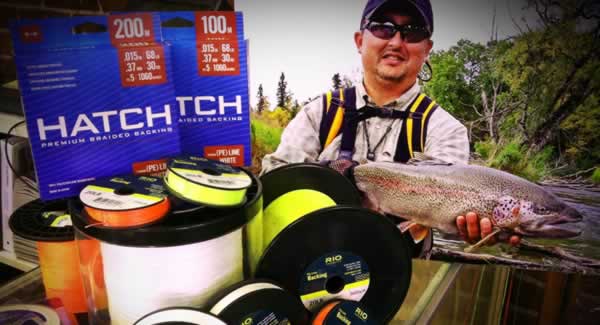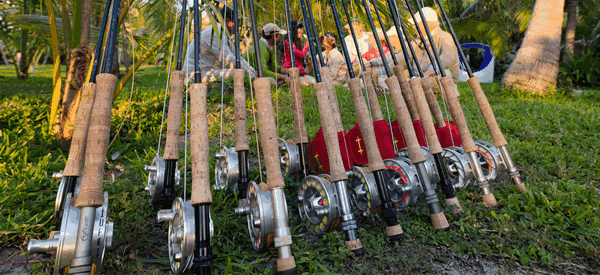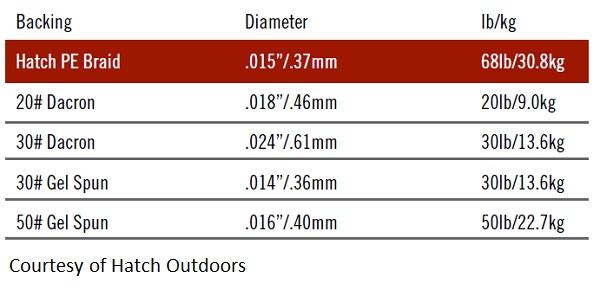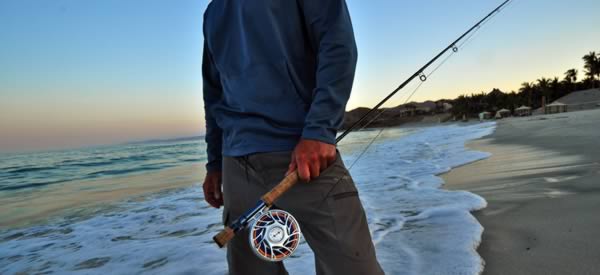Have you ever had a fish deep into your backing? Were you concerned about your backing? Is the idea of worrying about your backing so far down the list of importance that you think I'll worry about that issue when I get there. I would like to take a moment and explore the many varieties of backing and why you may want to find confidence in what's on your reel.
I may be overthinking this subject but it is my opinion that backing should not be overlooked. If you find yourself with a fish deep into your backing chances are you have put a ton of effort into this moment and a backing failure is just not acceptable. Fate will ultimately decide if that fish comes to hand and I want to do everything possible within my control to ensure an advantage...Don't you?
What backing is on your reels?
Do you know?
Is it important to you?
Will the intended species ever reach it?
If you don't know and you had the fly shop load your reels for you than you probably have Dacron backing. It’s the most common and accepted for many reasons. It's been around for a long time. Dacron has good properties of manageability, economical and readily available. So why use anything else? Well if you're like me you know you will make plenty of mistakes out of your control but let's not let what we CAN control become our mistake.
Most of the time Dacron is sufficient for our needs; after all how often does the species you fish for reach into your backing? So doesn’t it just take up space on your reel and makes a nice bedding for your fly line? If the answer is Yes, Yes and Yes then why would we consider anything else. Simple, because we can!
But first let’s take an in depth look at what Dacron is. Dacron (and also Micron, a trade name) is simply polyester spun fiber braided together to make a miniature "rope like†line. Its characteristics are soft to the touch, mostly limp and I as describe it I can’t help to think of it like a fleece jacket. Warm and cozy, soft and supple and very comfortable as long as it’s dry. Caution; it will absorb water. Typically found in 20lb and 30lb sizes but also might be obtainable in 12lb and 50lb strengths. It was the wonder line of its day.
So why Change?
Diameter per strength is one of the big differences that separates today’s super lines (gel spun types) from Dacron. Take a look at this chart for some comparisons.
Hatch Backing Chart: Courtesy of Hatch Outdoors
Notice the Hatch backing specs. We’ll talk more about Hatch backing a little later...
What I consider another major negative with Dacron is that it will absorb water. Does this matter? Maybe, let’s say you live in the northwest and always have your gear with you for that hour before work that you can hit your favorite Steelhead stream. You always keep it in the trunk of your car and although you gear is made to get wet, your backing never dries out. I have witnessed Dacron deteriorated from the effects of mold and mildew. Let your nose be the judge or just the unsightly look of black blotches on your backing may make you change your mind. A weak link on a chrome Steelhead is not an option! I for one take a lot of care and pride in my gear and blotchy black and smelly are not acceptable characteristics. But most of us will never witness this condition. Our gear comes inside to warm and dry after use.
I have also experienced the salt factor. When Dacron absorbs saltwater, and with saltwater species it is much more likely you’ll see that backing outside of the reel, the water will evaporate out of the line in the tropical sun but the salt will remain behind. I have stripped backing from reels months after salt use only to smell and taste the salt strong enough to give the sensation of being back on the flats. While our high end reels today are anodized with some space age materials developed by NASA, maybe…Salt is still a trump card, natures’ equalizer if you will, and it can still impose irreversible damage to your favorite reel.
Enough about Dacron!
Let’s explore the modern world of today’s super lines…
What are these super lines you speak of? Being a multi species fisherman for nearly four decades, I can honestly say I have watched the birth of the gel spun, Spectra, Dyneema and so on. All are basically the same fiber (polyethylene or PE) with certain variables such as how many strands or what are they coated with. The only one that stands out as somewhat different is the Dyneema which many of you would recognize as Fireline. Instead of braiding the gel spun polyethylene fibers, they instead are laid parallel and fused together. Steelhead anglers may be familiar with this line as it used as the trailing hook connecting line on most Steelhead string leach pattern flies.
Polyethylene or PE materials are not new. They have been in the fishing industry for decades now and have earned their rightful place. Even the concept of using these materials for fly reel backing is also not new. Many big game anglers have been using the yellow gel spun or the lesser expensive and more color available gear lines such as Power Pro, Fireline and Tuf-line. While a big advantage is strength I think the more important advantage is diameter. Diameter determines how much you’re going to get on a reel. Dacron of 30lb diameter is thick and takes a lot of reel space and that’s fine if you have the room. But nothing bothers me more than an overcrowded reel when maximum backing is required. And to further the problem is reel manufactures specs are not necessarily accurate to what they claim when it comes to backing capacity. Not that they are intentionally giving you false numbers but the Dacron itself can come in different diameters with the same pound ratings from different manufacturers.
Polyethylene Gel Spun make up all the super lines available to the best of my knowledge and what makes them different among the brands is how many strands are braided together and what are they coated with. This is where things get fuzzy grey…not all manufacturers publish these characteristics of their lines. It does make a difference in the line qualities. Example, have you ever used the plain old yellow gel spun offered by many of the fly line companies. It has a waxy feel and even leaves waxy residue on line guides. This is simply a coating, good or bad I don’t know but I do know it acts like a lubricant and makes a very slick line. Then comes color…some are dyed and I am sure of this due to the wear of these lines will strip them of their color. Let’s switch to strands. Most are at least three or four strands and I know of one up to 16 strands. Three and four strands typically are referred to as flat laying line, more strands are generally referred to as round. Hatch Backing is using an eight strand braid.

Advantages for Polyethylene (PE)
Thinner diameter to strength ratio… despite the many differences in diameter and strength figures one thing is clear that today’s super lines are stronger in every way over yesterday’s Dacron by far. Thinner diameter means either more backing line available if needed for the same amount of space as Dacron or the use of smaller lighter reels due to less space needed for Dacron.
PE is very long lasting since it doesn’t absorb water and these super lines tend not to rot or mold like polyester fibers will. Now be warned that doesn’t mean that the basalt rock of the northwest or the coral of the saltwater flats can’t inflict serious damage to your backing. It sure can and for this reason I would check all my lines before trusting them to that trophy Permit or Tarpon you’re chasing on the salt flats.
Another positive to make note of….thinner lines produce much less drag in the water and this can be a distinct advantage….example is have you ever had a fish turn direction on you? Fast swimming species such as Permit and Steelhead can turn on a dime and run much yardage very quickly leaving a bow in a thick backing. Many have made claims that this bow can cause such a resistance enough to cause leader breakage. I cannot back up these claims but am for sure that thinner lines pull less resistance on such fish turns and therefore are easier to catch up to. Benefit or not I don’t know but fact is a fact.
One more benefit I would like to point out that may be overlooked. If your 5 weight will most likely never see backing outside the rod tip for the species you are pursuing then why does a thinner backing matter at all. Here’s my take on this. Today’s rods are getting lighter and lighter and it only makes sense to lighten up your fly reel to match this trend. Some manufacturers are addressing this while others leave you wondering if they have cast a rod within the last decade. Put a heavy reel on a modern premium rod and you’ll wonder what is premium about that rod; but match a light reel to the rod and feel it come alive. One way to lighten up is go smaller but this also comes with a sacrifice…smaller reels usually mean smaller arbors…I am absolutely a fan of large arbor reels and that may be a discussion for another article but that fact remains my favorite rods are equipped with large arbor lighter reels. Stay on the smaller side and use a quality braid; it allows you to shave weight from your outfit and still get a sufficient amount of backing to balance out your needs.
The Negatives of PE
Cost…While more expensive than Dacron PE should outlast Dacron with ease provided it doesn’t fall victim to one of nature’s many line destroyers.
Cuts Easy…not to be confused with "easy to cutâ€! You will need scissors or a very good pair of nippers to cut PE. Cuts hands easy…I often hear complaints about hands getting cut up from PE. What are your hands doing on your backing when a bonefish is making his run? RELEASE THE BACKING! Why did you buy a reel with the best drag available if you are going to hold your backing…let your reel do the work! Funny thing is I usually hear these tales from people who have no proof they caught fish big enough to reach backing. I have never heard this complaint from those experienced anglers who I know have seen backing screaming off their reels many times.
Now for the endorsement! Of course there must be an endorsement. Why else would one write such an article!
Hatch backing…
Hatch Outdoors (Hatch reel manufacturers) build some of the finest top shelf fly reels on the market today. You only need to look at the list of
innovations to see the commitment these guys have behind their products. I also don’t want to forget to mention their service is as quality-driven as their products. So why would a reel company get involved in backing? I think the better question to our fly line companies is why haven’t you given us a better backing?
Hatch backing is produced with PE fibers like old yellow but that’s where similarities end. Hatch backing starts with 8 strand PE instead of the usual 3 or 4 strand used in others. Also by eliminating the waxy coatings and color dyes along with 8 strand Hatch found a PE that has the touch and feel of Dacron but with greater strength and smaller diameter. Other qualities include great abrasion resistance, UV resistant, low profile knots, less drag in the water and could possibly last your lifetime. I also like the one size covers all. Not that you would ever need 68lb strength on your trout rod but again forget the pound strength and focus on the diameter.
A vote of confidence…
So finally someone stood up and took backing seriously. This step forward has given me even greater confidence in Hatch reels. I see a reel company that looked outside their already outstanding product and said what can we improve and the answer was backing. By controlling the backing diameter Hatch has enabled themselves to accurately detail capacity of their reels with their backing. By reducing the diameter of backing
Hatch has enabled us to use smaller reels with larger arbors and still get sufficient backing needed; or obtain more backing for the times it is needed.
For sure there are as many opinions as there are fly rods today and the right answer is up to each and every angler.
This story just contains the ramblings of a tormented angler!
Article by: Greg Darling


